AC Milan were beaten 3-1 by Borussia Dortmund in matchday five of their Champions League campaign, taking the fate of their qualification hopes out of their hands. The Rossoneri can still progress to the knockout stages if they win at Newcastle and Dortmund beat PSG in the final round of games in two weeks time.
In a lively start to the match, both teams were awarded penalties within the opening ten minutes. Whilst Oliver Giroud failed to convert Milan’s spot kick, Marco Reus made no mistake with his, to put Dortmund into an early lead.
The action did not end there though, with neither team seemingly interested in slowing down the end-to-end nature of the game and both teams attacking the other at every opportunity. Milan leveled proceedings in the 37th minute, when Samuel Chukwueze finally showed the San Siro crowd why he was brought to the club in the summer. The Nigerian winger beat two opponents on the right wing before cutting inside onto his favoured left foot to whip the ball low and into the far corner of the net.
In the opening five minutes of the second half, Milan looked to be in the ascendancy, with the ball barely leaving the Dortmund defensive third. However, in the 51st minute, Milan suffered the first of a series of setbacks.
Malick Thiaw pulled up after ushering the ball out in a 1v1 duel against Jamie Bynoe-Gittens. With a lack of options on the bench, the German centre-back was replaced by midfielder Rade Krunić to play a makeshift role in the backline.
From this point forward, the momentum of the game seemed to immediately swing towards Dortmund. The visitors took the lead not long after this, but not before, in Stefano Pioli’s words: “…we lost it when we missed a 3-on-1 counterattack.” Referring to the 57th minute when Ruben Loftus-Cheek failed to capitalise upon a promising breakaway.
And the home team were left to rue this missed opportunity, when on the hour-mark Bynoe-Gittens made it 2-1. Ten minutes later, it was 3-1. Mike Maignan first failed to get a strong enough hand on Karim
Adeyemi’s shot and then failed to prevent it crossing the line. Dortmund defended out the remainder of the game relatively comfortably, with a Luka Jović header and near post shot providing the biggest threats to any potential Milan fightback.
The victory progressed the Bundesliga club into the last-16, whereas for the Serie A side they were left wondering what might have been had they been more clinical throughout their 2023-24 European campaign. Their wastefulness started with the home draw against Newcastle and continued with Giroud’s penalty miss in this fixture.
In what was a topsy-turvy ninety-minutes plus, here’s @Tactics_Tweets to provide his observations.
Set-ups
Stefano Pioli welcomed Giroud back into his side following his domestic suspension this past weekend. The Milan manager also brought in Loftus-Cheek and Yacine Adli into midfield alongside Tijjani Reijnders to give his side an attacking look. In and out of possession, the Milan team and players showed similarities to how they attacked and defended against Fiorentina in their last fixture.
In attacking phases, both Davide Calabria and Theo Hernández advanced to provide the team width which enabled Chukwueze and Christian Pulisic to play more centrally, as opposed to wide forwards. Apart from the two centre-backs, the rest of the Milan team very much demonstrated elements of fluidity when in possession. The players appeared to be given the license (within reason for each role) to interpret which spaces to occupy according to where the gaps were in the Dortmund defensive shape and therefore were dynamic in their positioning.
In defensive phases, the home team started the game with two banks of four and Loftus-Cheek switching between being closer to Giroud or the midfield unit depending on which third of the pitch Milan were defending. Like versus Fiorentina, Milan began more zonally and ball orientated as opposed to any players / units having specific man-marking responsibilities (with some exceptions when their pressing-scheme was triggered).
But Pioli must have been dissatisfied with this approach as towards the end of the first half, he used a Gregor Kobel treatment break as an opportunity to make some tactical adjustments. Post this, the Milan central midfielders, specifically, became more player-orientated which ultimately contributed to some costly consequences. More on this later.
For Dortmund, Edin Terzić made one change to the team which beat Borussia Mönchengladbach the Saturday prior, with Donyell Malen replacing Julian Brandt. The visitors mostly resembled variations of a 4-4-2 / 4-4-1-1 without the ball, but with it they shared some similarities to the hosts.
As seen below, their full-backs advanced high, allowing their forward line to occupy central areas of the pitch, with Marco Reus, Emre Can and Sabitzer rotating in behind to help with retention, progression and creation in midfield. This left Mats Hummels and Nico Schlotterbeck as their deepest players to provide protection.

Getting it ‘right’ in attack
Milan’s goal, and the majority of their attacking play, came down their right-hand side. And this right flank bias is backed up by the stats. According to Wyscout, 42% of Milan’s attacks and 44% of their xG were generated via their right wing – showing both the frequency in which it was used and its effectiveness.
Much of this right wing threat can be linked, and owed, to the ‘structure’ Milan were using when in possession which the Rossoneri first trialed against Fiorentina this past weekend – as you can see below.

The arrangement of this ‘structure’ against Dortmund involved; Tomori and Thiaw at the base, with Adli and Reijnders ahead of them finding spaces in and around the top of the Dortmund defensive block to help with ball progression and retention. Both of these midfielders could pull wider, on the outside of the Dortmund block, pulling out an opponent in the process to create gaps elsewhere for the trio of Pulisic, Loftus-Cheek and Chukwueze to exploit.
As mentioned, the full-backs provided the width, but could interchange with teammates if desired, and this left Giroud to lead the forward line and provide a central focal point, aiming to occupy the Dortmund centre-backs in the process. Whilst these descriptions were each player’s foremost roles, dynamism was a key element of Milan’s attacking threat, with players – especially in central areas – constantly moving into the new spaces which appeared in between the Dortmund block.
The premise behind Milan’s ‘structure’ was to create both numerical and positional advantages against the Dortmund defensive system (which aimed to be compact). By forcing their opponents into decisions, Milan could manufacture weaknesses (spaces) in their opponents organisation which they could then exploit.
The primary examples being, lots of central occupation causing Dortmund to narrow further and therefore affording Milan more space to penetrate out wide. And then if Dortmund reacted by engaging out wide, new options (gaps) to penetrate infield could appear.
And as these following examples will showcase, Milan’s principle attacking tactic against Dortmund was to manufacture penetration opportunities down their right-hand side.
What better way to show Milan’s intent than a sequence within the opening minute. Below, Milan had possession with Tomori and faced a settled Dortmund defensive mid-block. You can see Loftus-Cheek and Pulisic taking up positions in between and in behind the Dortmund midfield line and Adli making a movement outside of the block to receive a pass from Tomori.

In the image above, notice how Calabria and Chukwueze were both initially in the right channel. But fast forward 14 seconds later, and after dragging Dortmund over to the Milan left-hand side, on the opposite flank, Milan’s right-sided players were making coordinate movements to manufacture space to attack.
Chukwueze moved infield to pin Bensebaini (Dortmund left-back) and Calabria advanced to penetrate in behind. Adli already knew the plan, and played a diagonal switch which shortly after resulted in Milan winning an early freekick, high in the opposition half.
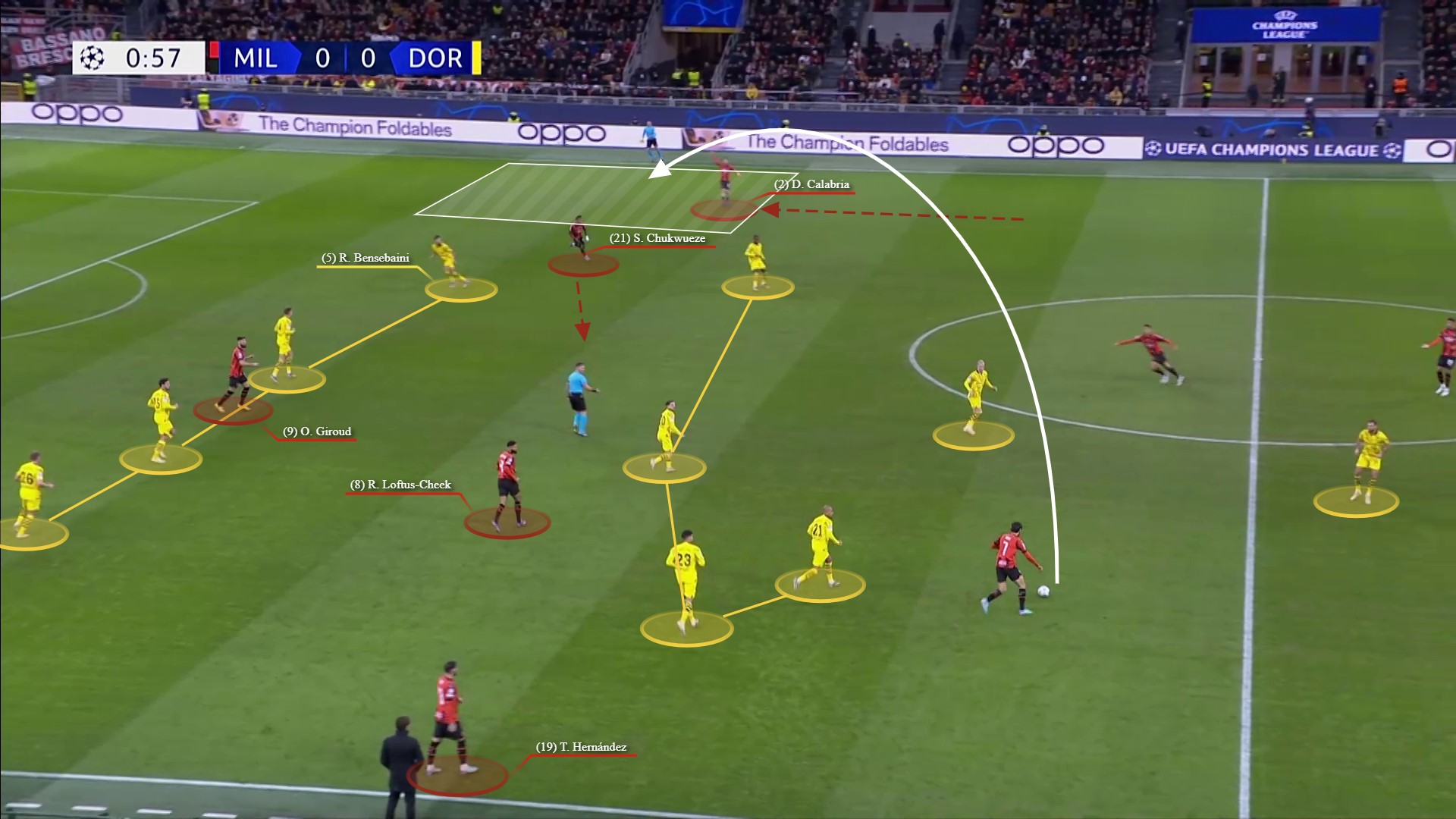
Less than five minutes later, a similar scenario occurred. Adli pulled outside of the Dortmund block to get on the ball, attracting a Dortmund player with him which allowed for a pass to Thiaw to receive with space ahead. Also note below, how Chukwueze’s movement infield has again pinned Bensebaini, making it risky for him to cover Calabria on the outside.
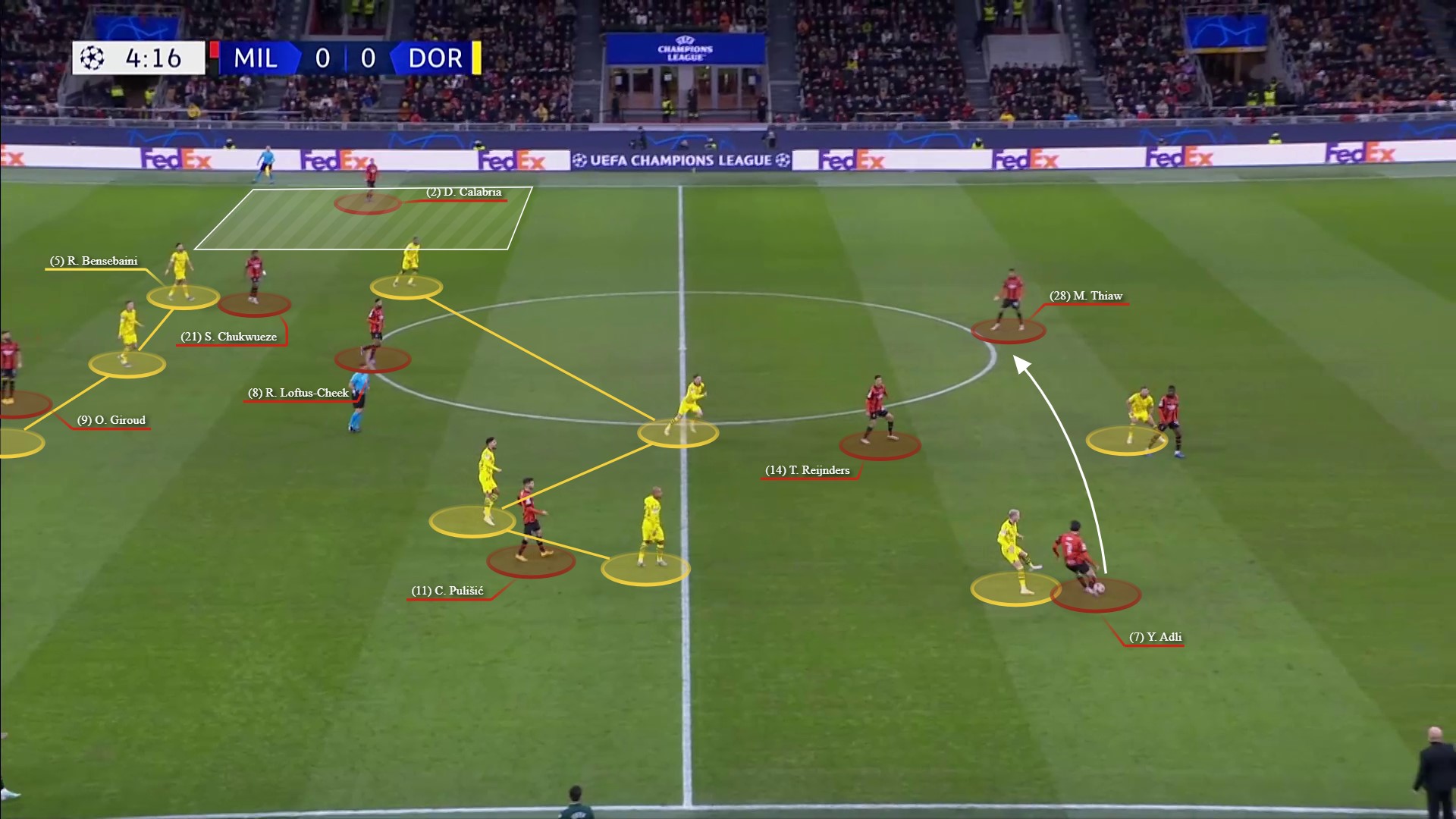
As a result, a pass can be made to Calabria (nearly Milan’s most advanced player) to penetrate immediately in behind the Dortmund backline. Additional observations from the below image are; 1) Loftus-Cheek central positioning here helped draw out Nico Schlotterbeck from the Dortmund backline, and 2) Chukwueze and Giroud (who made a movement to be on the inside of Hummels) were preventing the two Dortmund defenders from getting out to close down Calabria.

Despite Calabria putting the ball into a dangerous area, it managed to somehow evade both Chukwueze and Giroud…
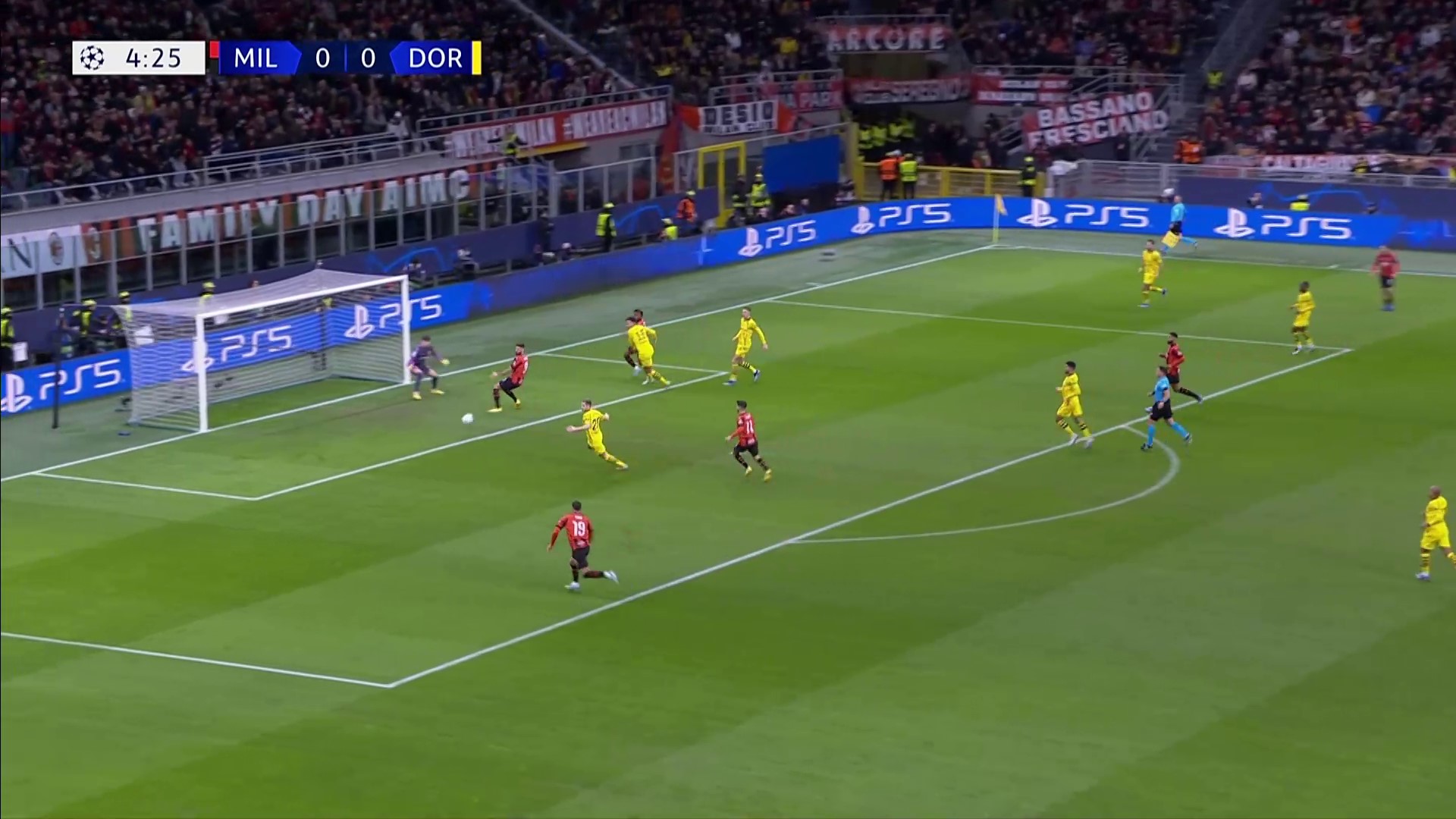
…and Dortmund were able to regain possession before initiating a counterattack. This attacking transition was actually prevented however, and Milan re-countered themselves which led to them winning their early penalty.
As readers will already be aware, this right wing attacking bias also eventually led to Milan’s equaliser in the 37th minute. The sequence started as the previous examples did, Milan with possession in front of a settled Dortmund 4-4-2 mid-block, with lots of space on the right-hand side, aided by Chukwueze and Calabria’s coordinated off-ball movement.
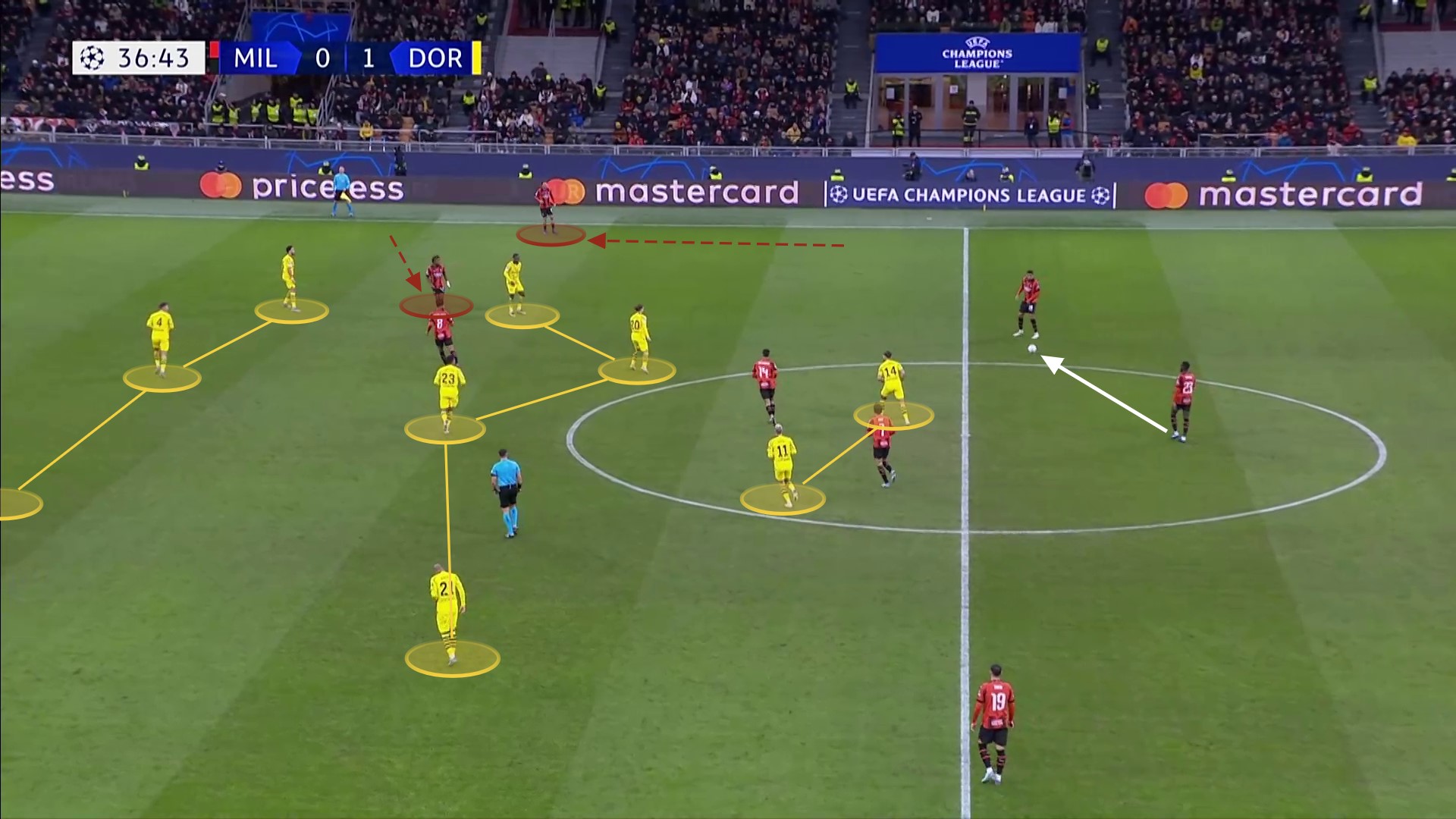
On this occasion, with Bensebaini perhaps deciding he (and his teammates) were set in a solid defensive position, he jumped out to engage Calabria. However, in the perfect demonstration of how this Milan tactic (exposing Dortmund’s wide weakness) could manufacture new options (gaps) to penetrate infield, Chukwueze made an underlapping run to penetrate in behind which was found.
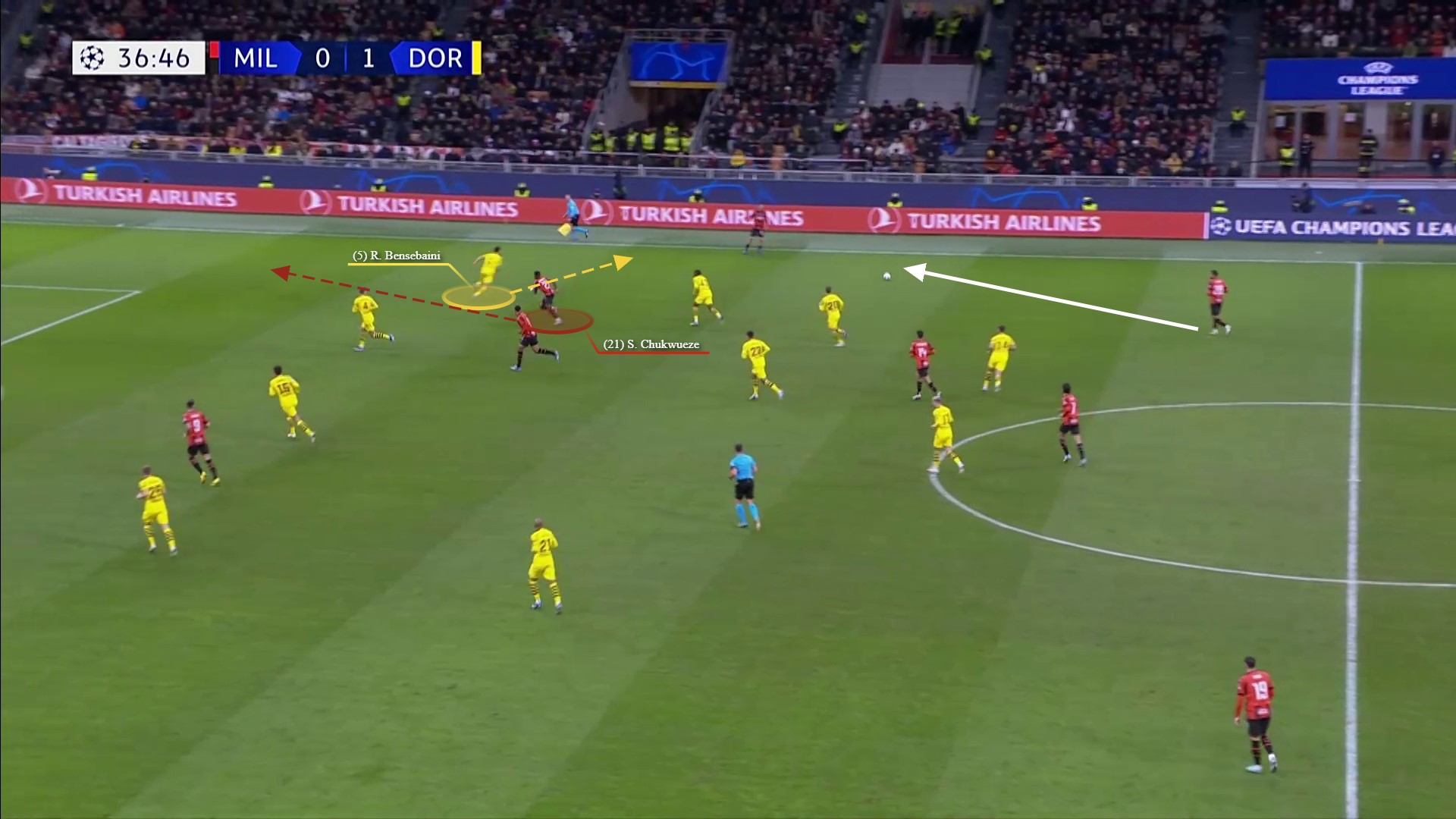
The rest of the action, well that all was down to individual brilliance with a dash of poor defending, as the Nigerian winger cut in between two opponents before striking into the far corner.
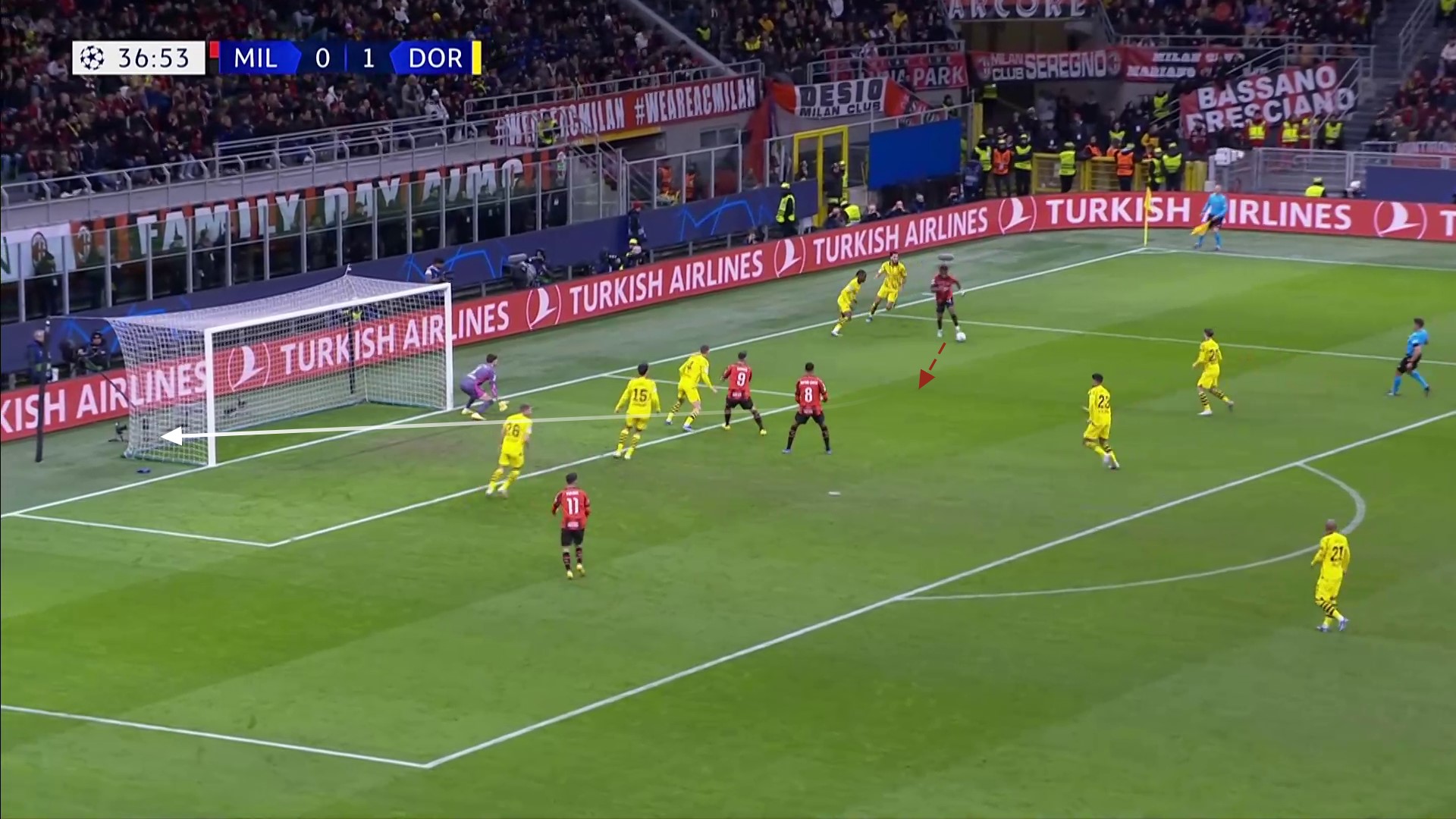
But Milan’s right-side attacks did not stop there. Before half-time, they created a further two opportunities from this pattern of play. First, in a reverse scenario, Calabria was doing the infield pinning, allowing Chukwueze to stay out wide. After carrying forward and forcing the Dortmund backline and midfield further and further towards their own goal, Chukwueze cut inside and laid the ball back to Adli in space on the edge of the area whose tame shot was easily blocked.
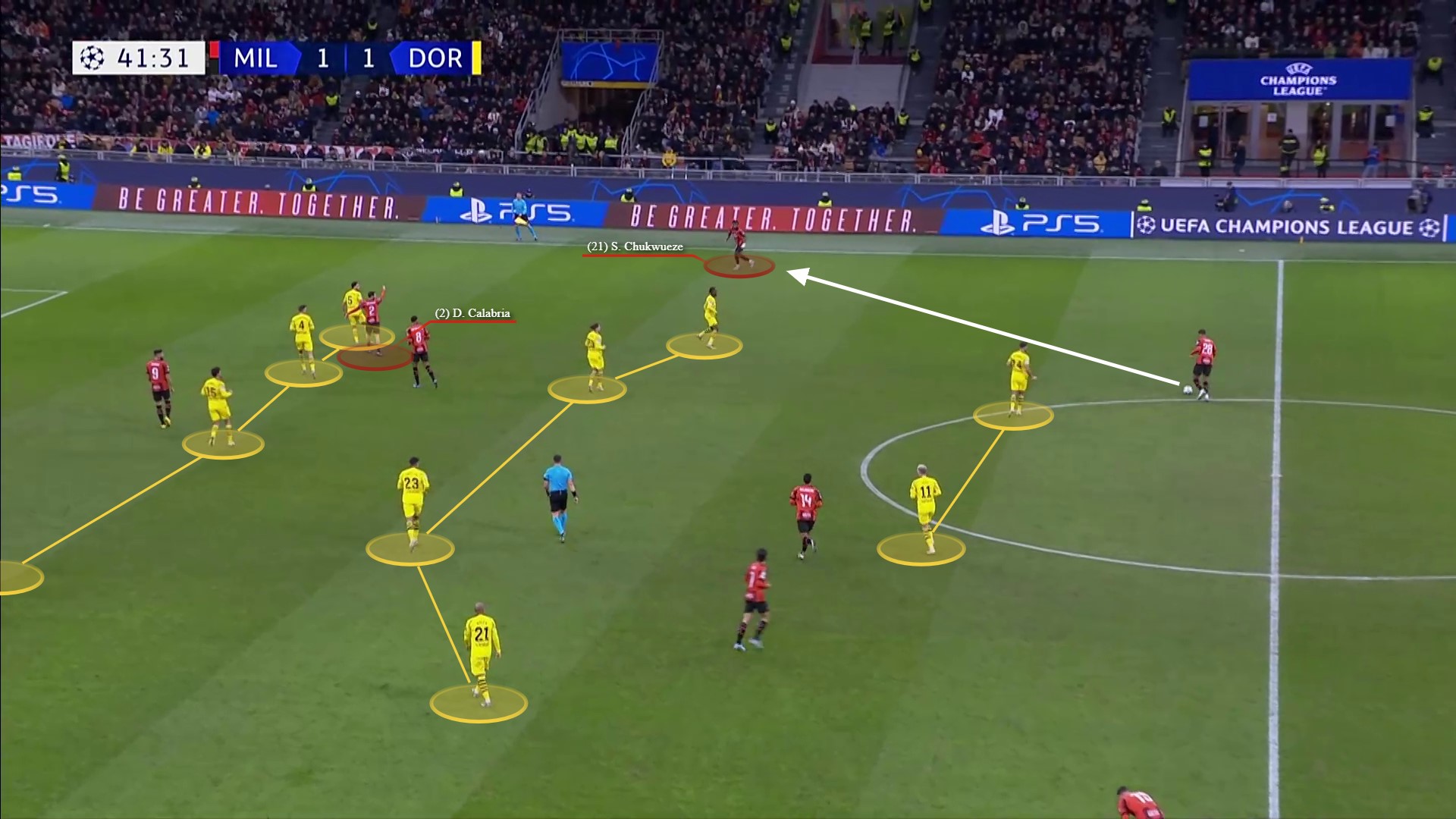
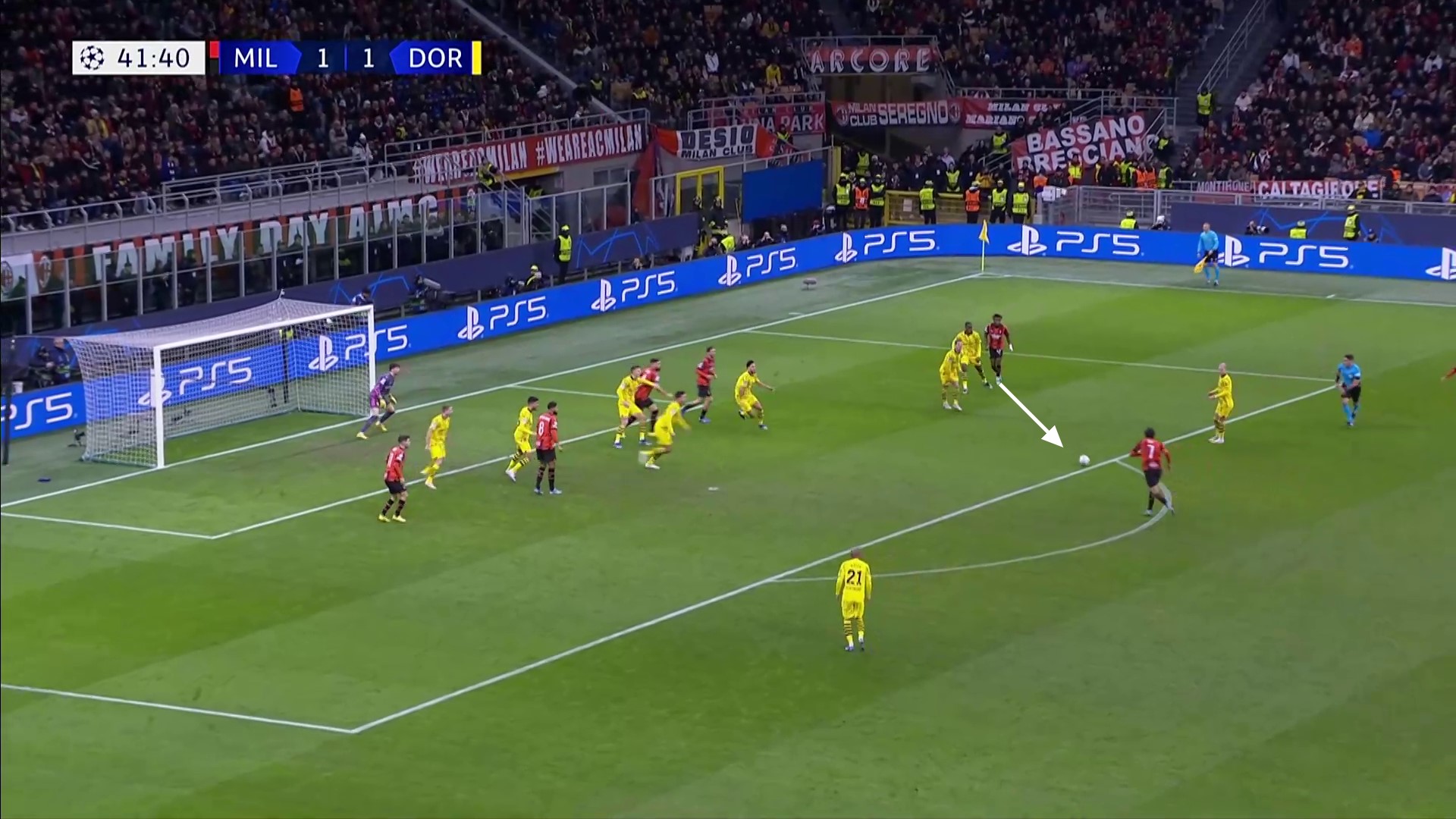
And finally, perhaps Milan’s best chance of the first half. After a long goal kick, Milan won the ball deep in Dortmund territory, and from here, Pulisic cut inside from the left to curl a cross towards the far post, where Calabria – still playing his advanced role – attacked but headed wide (perhaps one of the downsides of attacking with your full-back…).
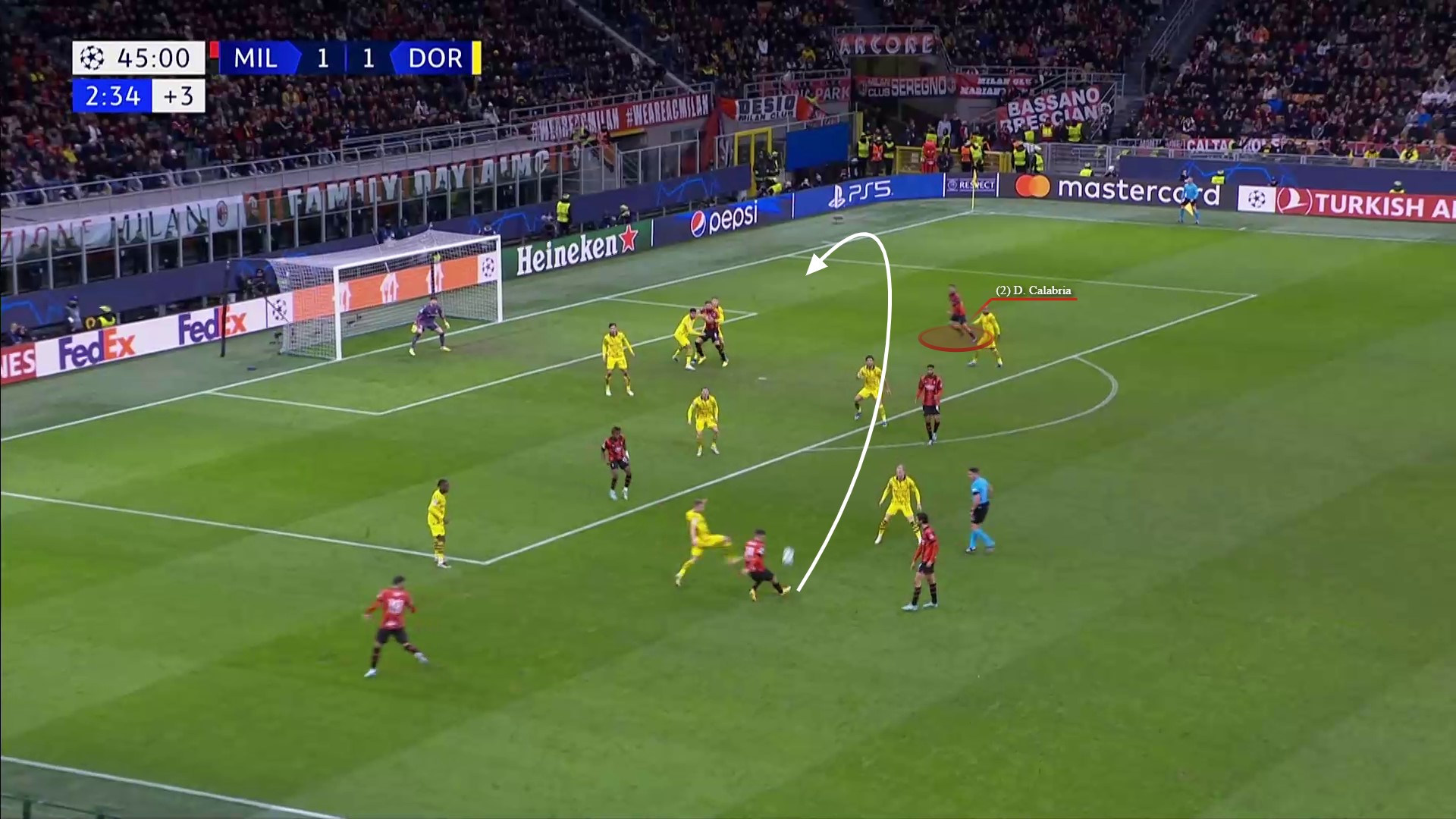
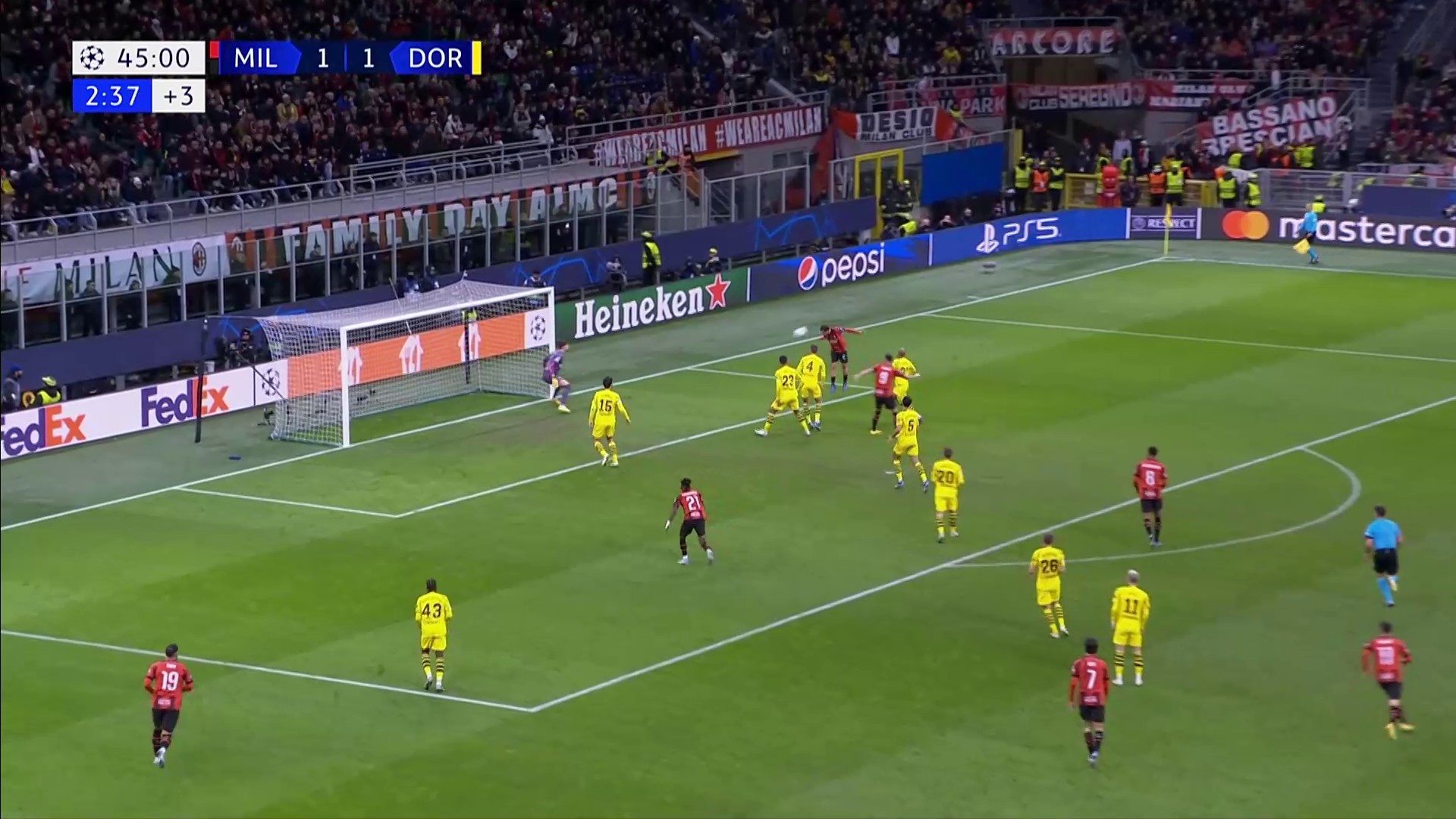
And from an attacking perspective, that was Milan’s opening forty-five minutes. They got plenty ‘right’, in more ways than one, but only managed to convert one of their many chances. However, anyone who watched the game will be fully aware that the first-half was far from one-way traffic.
Whilst Dortmund prioritised protecting central areas of pitch – so therefore allowed what they deemed the lesser of two evils e.g. a wide weakness (which Milan did well to exacerbate) – another aspect to consider in this is the weakness Calabria (and Hernández) playing so high created for Milan in transition which Dortmund repeatedly attempted to exploit, albeit without any direct outcome. Allowing a weakness to exploit a weakness, perhaps…
But being exposed in transition was not Milan’s only issue out of possession. And ultimately, a failure to find the right solution to their defensive issues, ultimately cost them the game.
Failing to the find the ‘right’ solution in defence
Against Fiorentina on the weekend, Milan altered their usual approach in defensive phases and repeated this plan for Dortmund. The home side were more zonally and ball orientated as opposed to any players / units having specific man-marking responsibilities.
This manifested itself in predominantly two banks of four, with Loftus-Cheek jumping up alongside Giroud when defending high and dropping lower to support his midfield unit when protecting the Milan box – as seen in the two visuals below.


But much like their Italian hosts, Dortmund were also advancing their full-backs in attack to exploit spaces in wide areas. In the second image above, see how Bynoe-Gittens had moved infield to pin Calabria, allowing Bensebaini space to receive the diagonal pass and attack down the byline.
So the Milan right-hand side, which would be a benefit in attack, was going to be targeted as a potential weakness in defence. And just over a minute after the above attack, Milan fans need not be reminded, but a Dortmund attack down the left wing led to them winning a penalty and taking the lead. And in total, across the whole game, 49% of Dortmund attacks came via their left flank.
Now, all defensive tactical plans will have aspects of managing trade-offs, or picking your poison if you will. For Pioli, he decided to start with this approach as the upsides helped his team maintain compactness and coverage across the pitch, plus, it relatively simplifies the players defensive responsibilities.
The downsides, it resulted in being passive without the ball, allowing Dortmund possession and therefore progression up the pitch, and, as we’ve seen, it allowed weaknesses in wide areas to be potentially exploited.
But Dortmund’s central rotations were also beginning to cause Milan problems, as can be seen here in the 27th minute. After the away side easily progressed the ball in build-up, Sabitzer pulled to receive a pass which attracted Reijnders to jump.

In addition to this, Reus made a backwards movement which initially caught the attention of Adli. After some Dortmund combinations, their central rotations had helped manufacture a passing lane for Schlotterbeck into Malen in space between the lines.
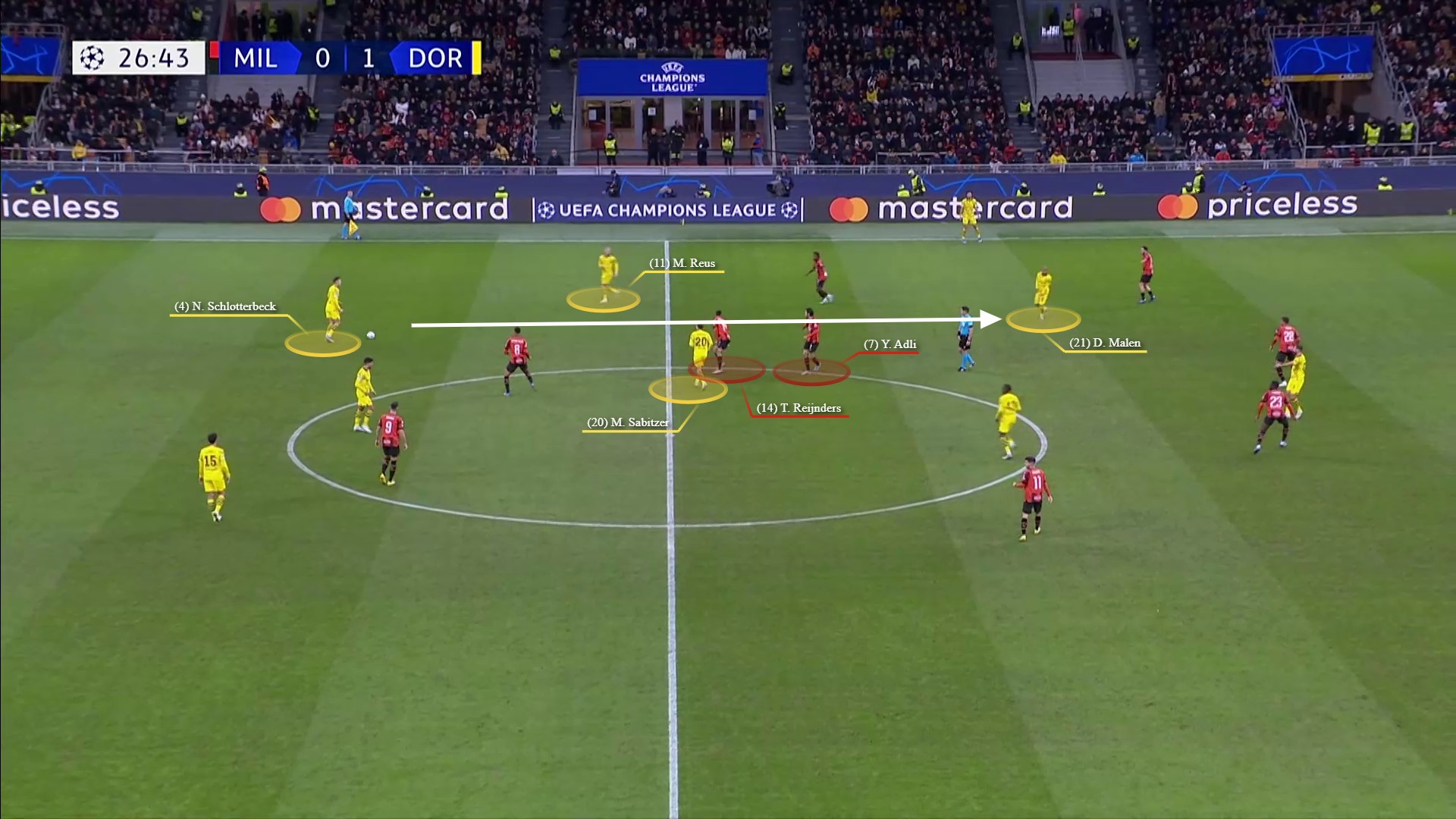
The pass was then made out wide – yes, to the left wing – where the advanced Bensebaini had space to cross but the Milan defenders were able to clear.

Shortly after the above passage of play, Pioli spent some time during a Kobel treatment break to chat to his players, including Adli (extremely speculative image below).

And when play resumed, Milan looked to be using a different approach out of possession. Reverting back to their central midfielders becoming more player-oriented e.g. closely tracking Dortmund central players.
Here’s an instance from the 36th minute, where you can see following some Dortmund build-up play, Adli, Reijnders and even Loftus-Cheek have each been pulled into different areas of the pitch which had a consequential impact of allowing space in front of the backline for Bynoe-Gittens to receive, another Schlotterbeck, line-breaking pass.

From here, Bynoe-Gittens attacked the Milan backline before passing to Malen who opted to shoot instead of using the free player on his outside.

Here’s another example from the 41st minute, where Milan’s midfielders were each tracking a Dortmund opponent as a priority, as opposed to maintaining any compact, zonal team shape. In this scenario, you can also see how Pulisic’s role changed too, with him jumping to engage Hummels (right centre-back), thus leaving Ryerson as often the free player for Dortmund in attack.
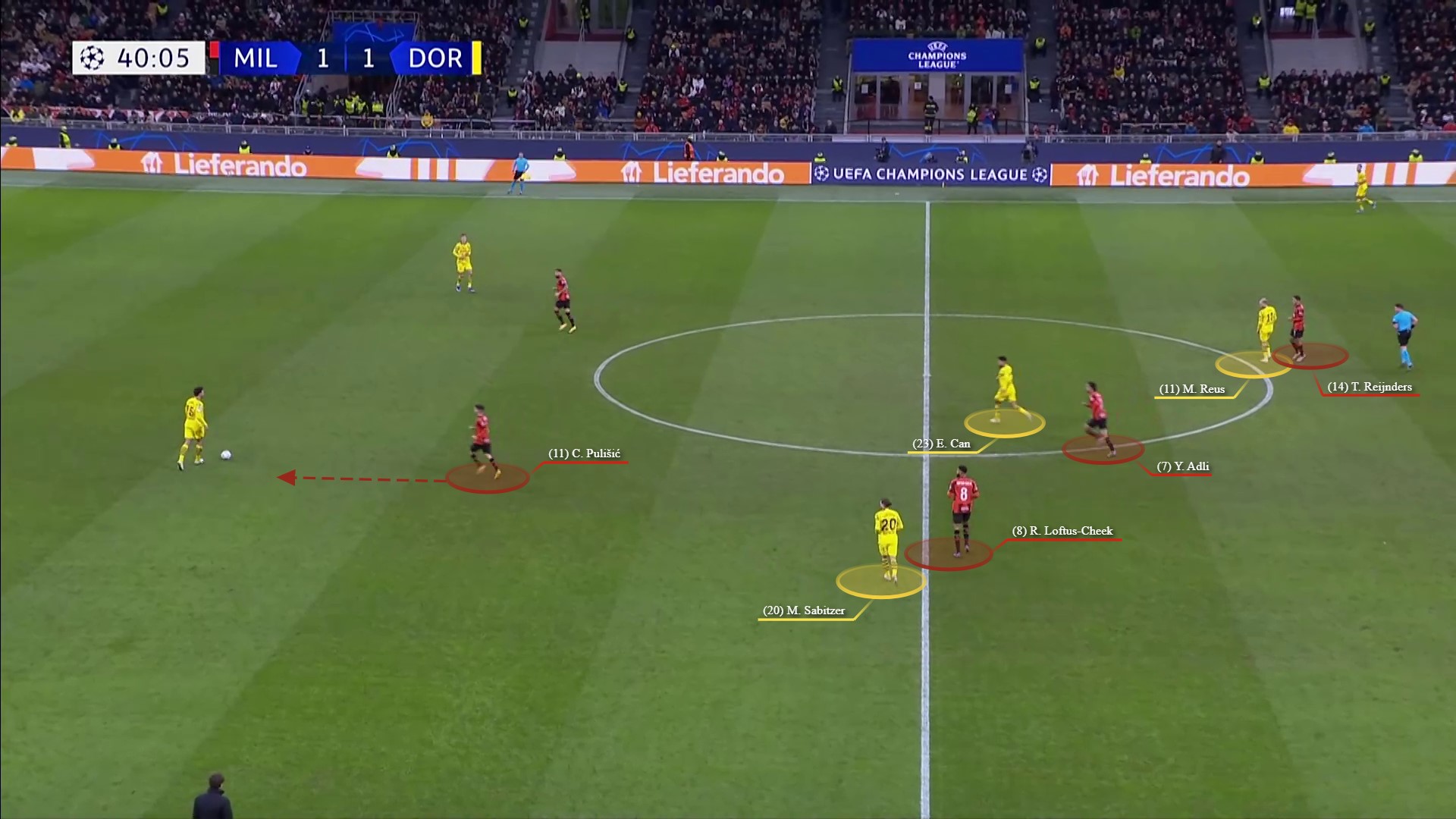
This tweaked defensive approach continued into the second half, with their midfielders each in close proximity to a Dortmund opponent and Pulisic pushing up to engage Hummels. Also note how Ryerson was now free on the right wing.
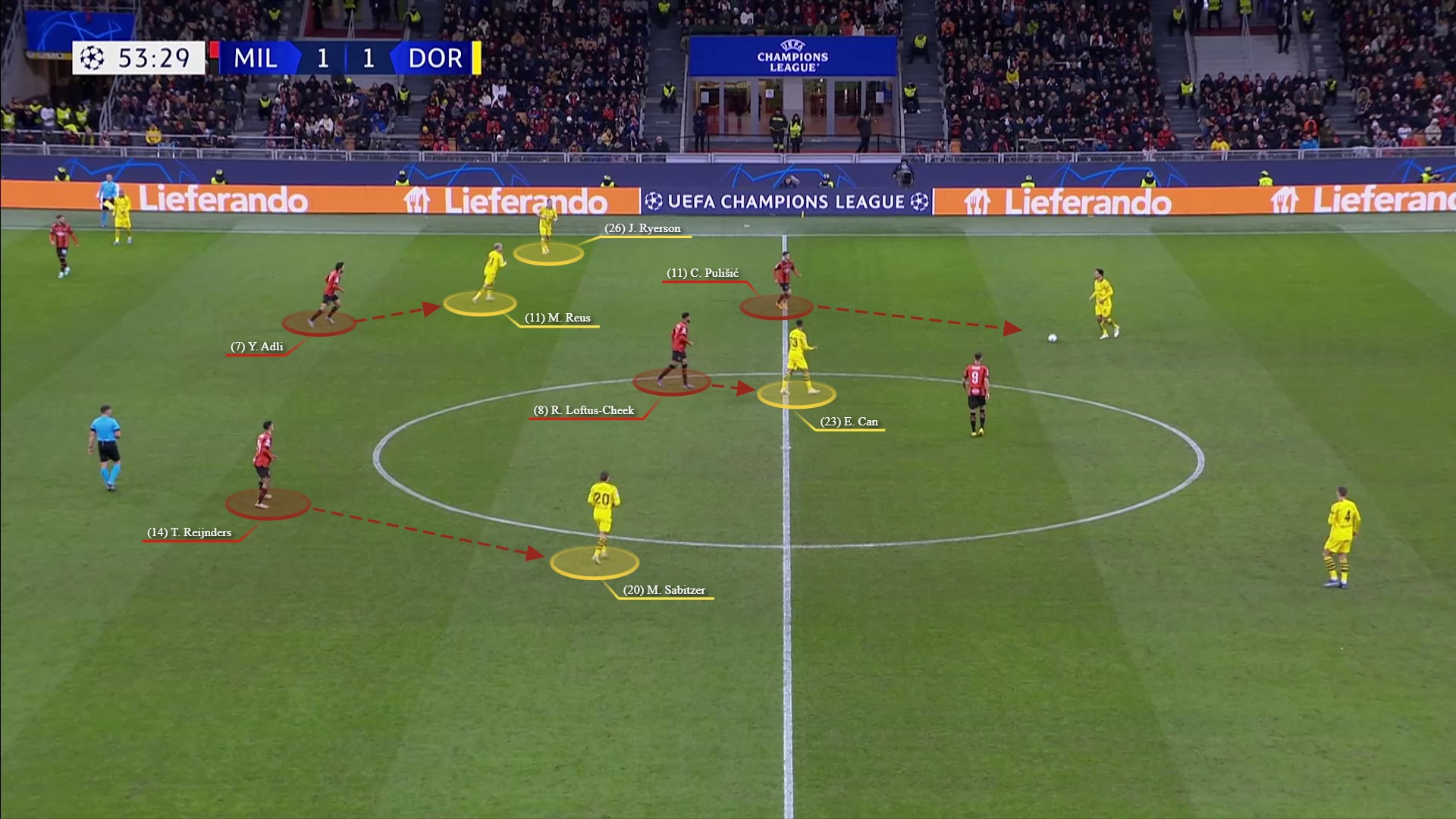
Milan’s new intention in defensive phases therefore appeared to be, being more proactive without the ball as a proposed solution to presumably prevent Dortmund having such uncontested possession and progression. But as previously highlighted, whilst this tweaked approach would have brought its own specific upsides, it also inevitably came with the byproduct of its own downsides.
And these came in the form of Dortmund being able to manipulate the Milan players, and therefore defensive organisation. In this situation in the 57th minute, notice how disjointed the Milan team is compared to instances in the first half.

As play progressed in this action towards the attacking third, see how Adli was unsure as to whether to support Calabria in a 1v1 against Bynoe-Gittens or stay with Reus, in the end, he ended doing neither an easy pass was made into Reus, in space between the lines.

For reference, in the above example, Milan regained the ball on the edge of their area and then had their “missed” 3v1 counterattacking opportunity. But instead, the scoreline remained level.
That was until the 59th minute, where a deep Dortmund freekick started proceedings. With Pulisic performing his job of closing in on the right centre-back, this left Hernández with a 2v1 overload on his side. In central areas, the Milan midfielders were each player-orientated as evidently instructed.

With Can able to access Adeyemi, Dortmund had entered the final third, and with Hernández still up against two opponents, he needed Adli to pass on Reus to help support. But with Reus now free – which Tomori tried to alert his teammates too – Dortmund still had a 3v2 advantage on the right wing.
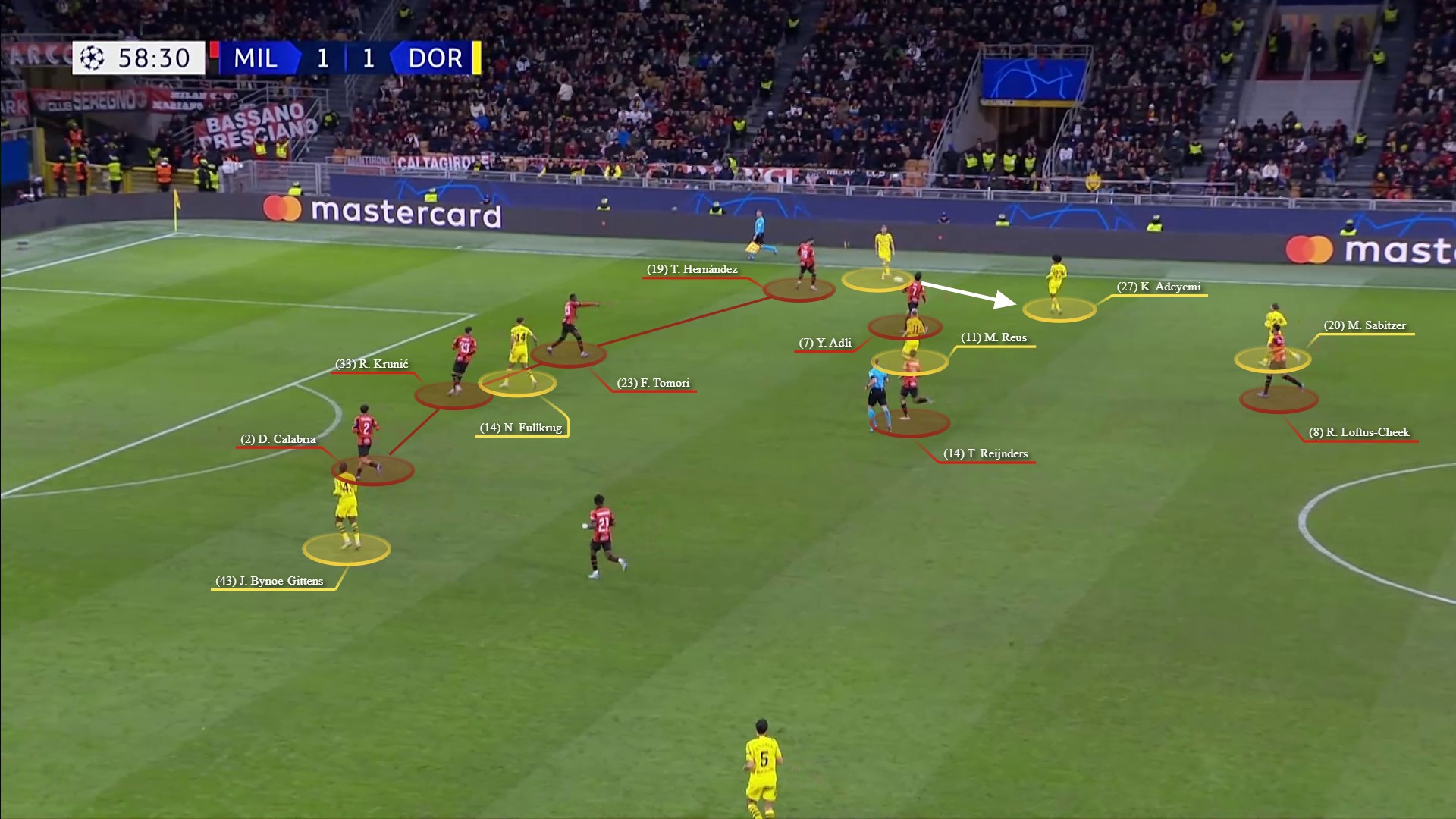
With Reus still unmarked, he was able to receive and get his head up where he saw Füllkrug offering to drop short. At the same time, Sabitzer had drifted on the blindside of Loftus-Cheek to make a run towards the Milan backline.
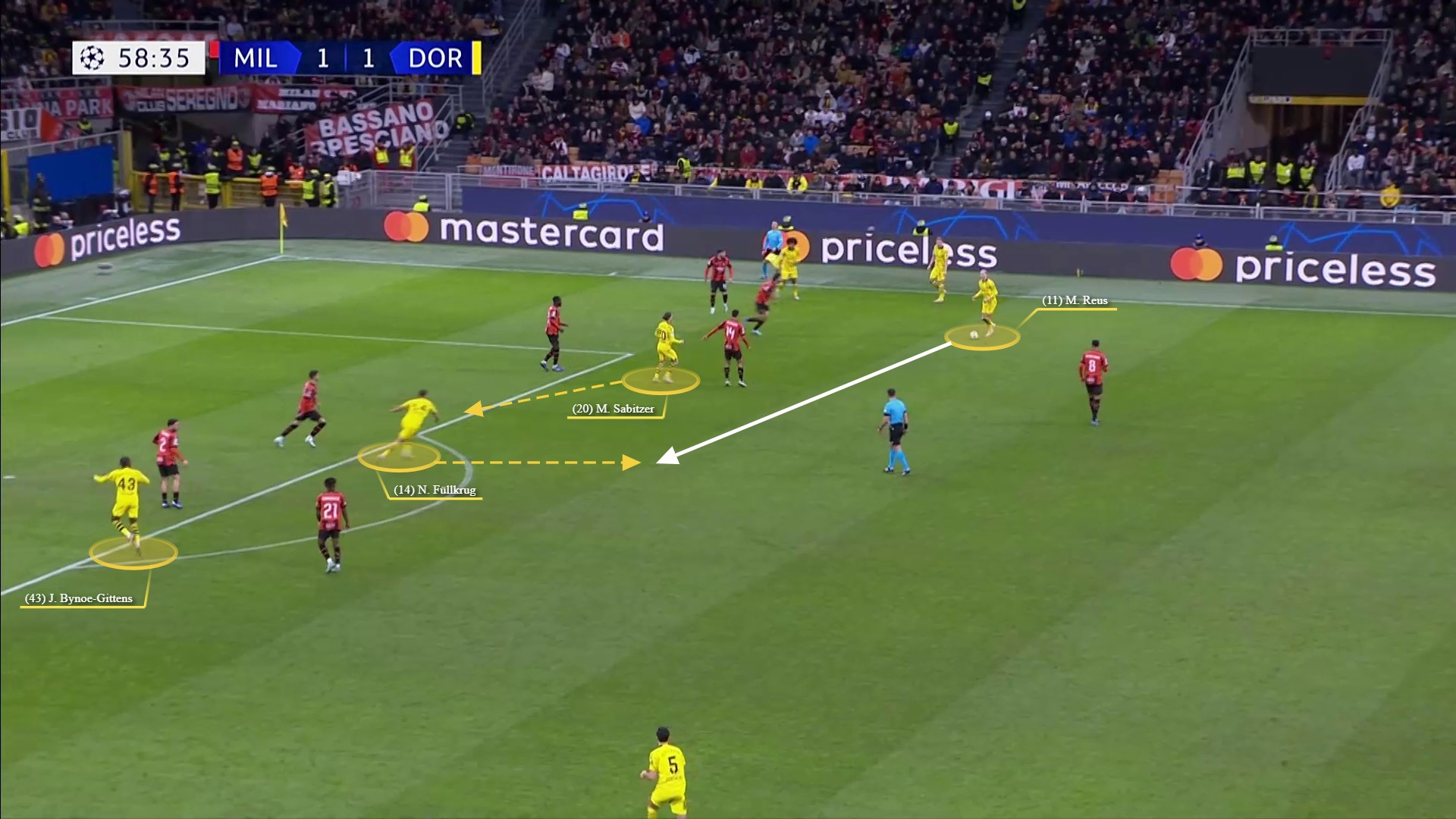
Where he received Füllkrug’s first-time pass inside the penalty box. This fact attracted Calabria and as a result, Bynoe-Gittens was left free in behind (with Chukwueze too slow to spot the danger). Sabitzer managed to poke the ball through to him and the young attacker finished to make it 2-1.

Ten minutes later came Dortmund’s third. This goal was slightly more rudimentary but Milan’s out of possession tactics also played their part. It started with a Dortmund goal kick, and Can’s possession of the ball triggered Pulisic’s engagement, leaving Ryerson free on the right flank.
In an attempt to cover, Hernández preemptively jumped, leaving the Milan backline in a 3v3 situation. Assessing and executing this in real-time was Can who reacted by playing a long pass forward…
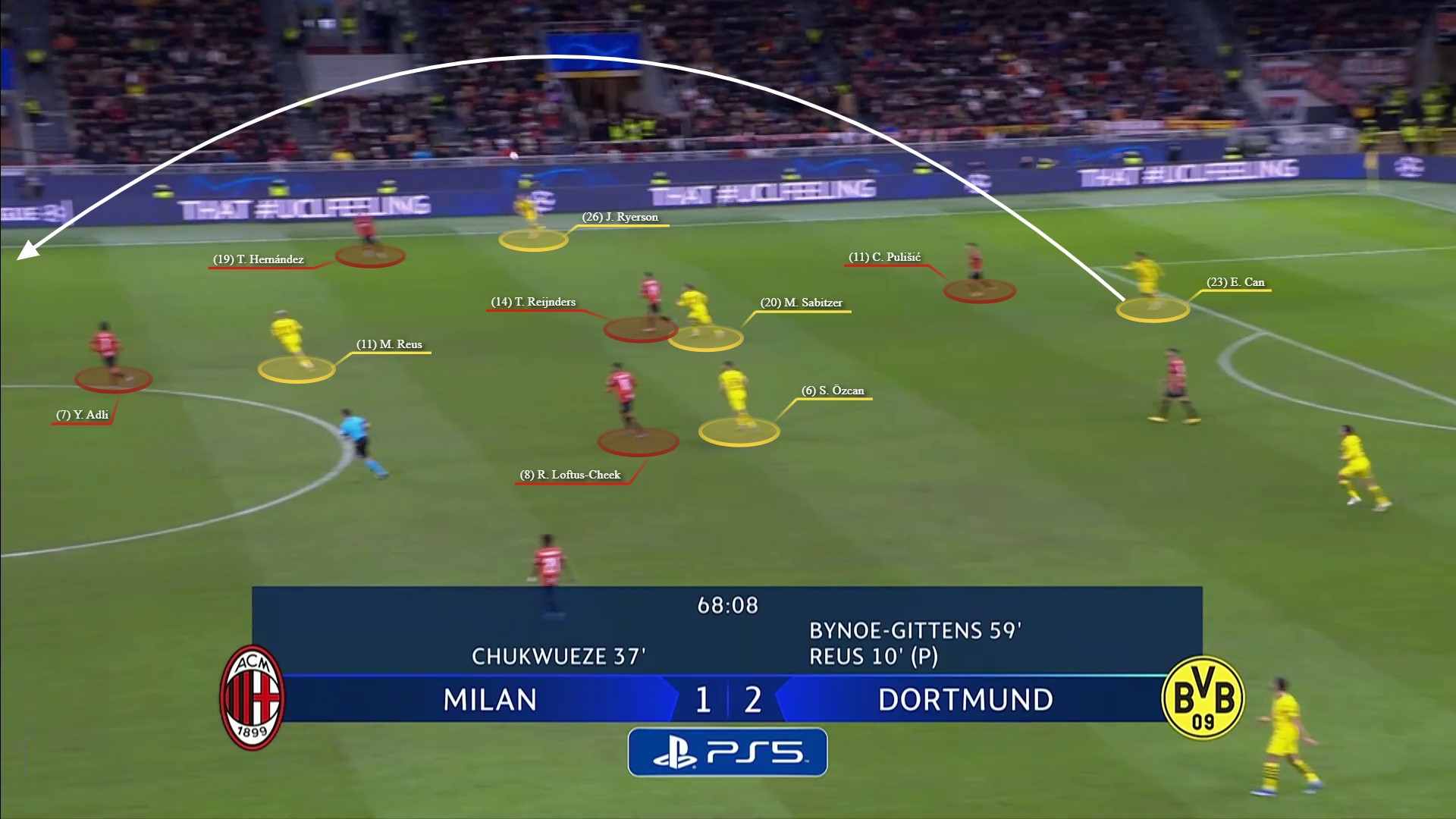
…for Füllkrug to win the duel and lay into the path of Reus who out paced and muscled Adli before passing to Adeyemi who cut onto his right-foot to shoot and score courtesy of a rare but poor goalkeeping error from Maignan.
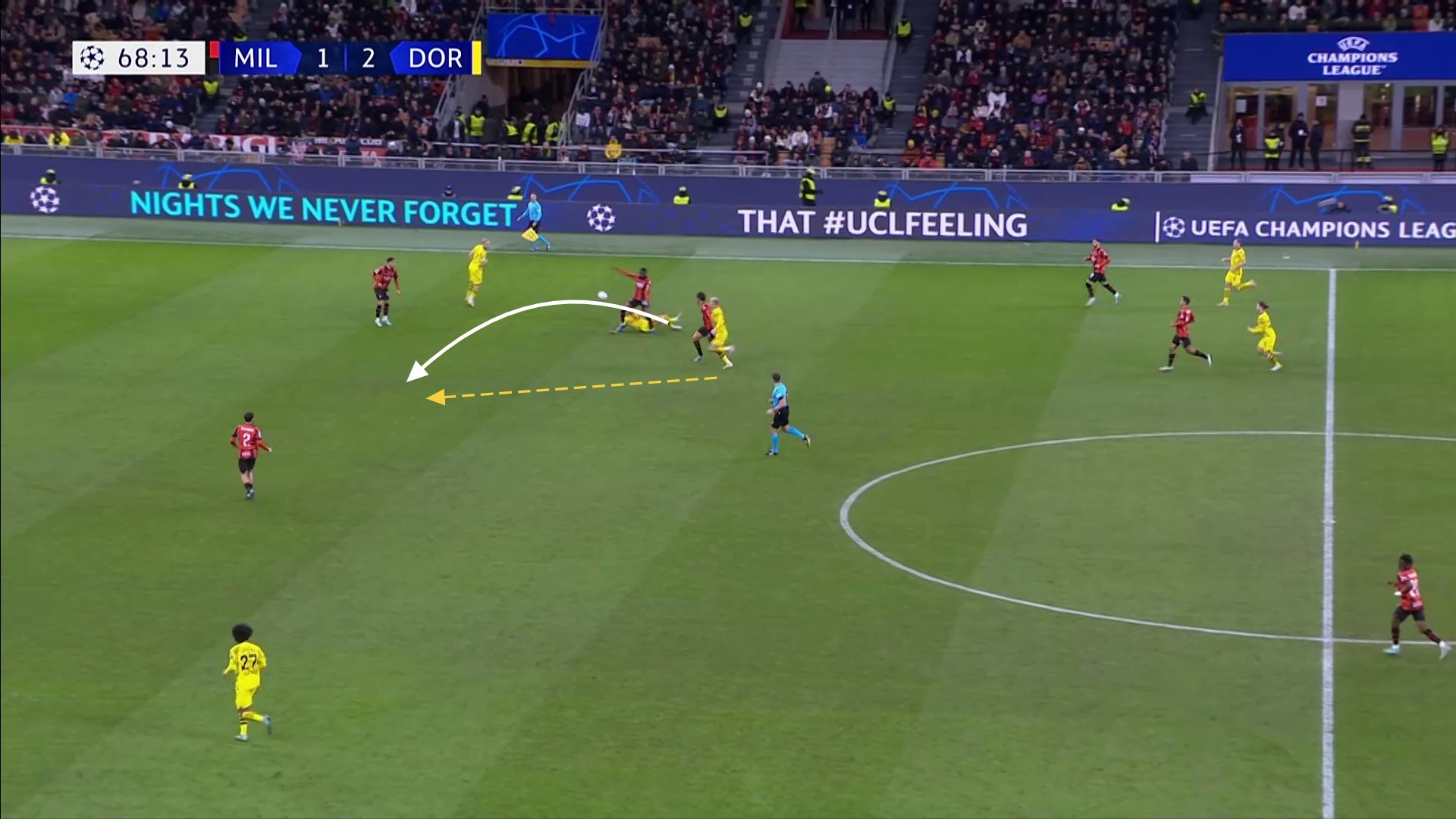

Conclusion
Milan were unable to find a way back into the game. Much like how Piolo was unable to find the right solution to prevent Dortmund’s attacking threat. And whilst not completely dead, the odds are now firmly stacked against the Rossoneri qualifying from the ‘group of death’.


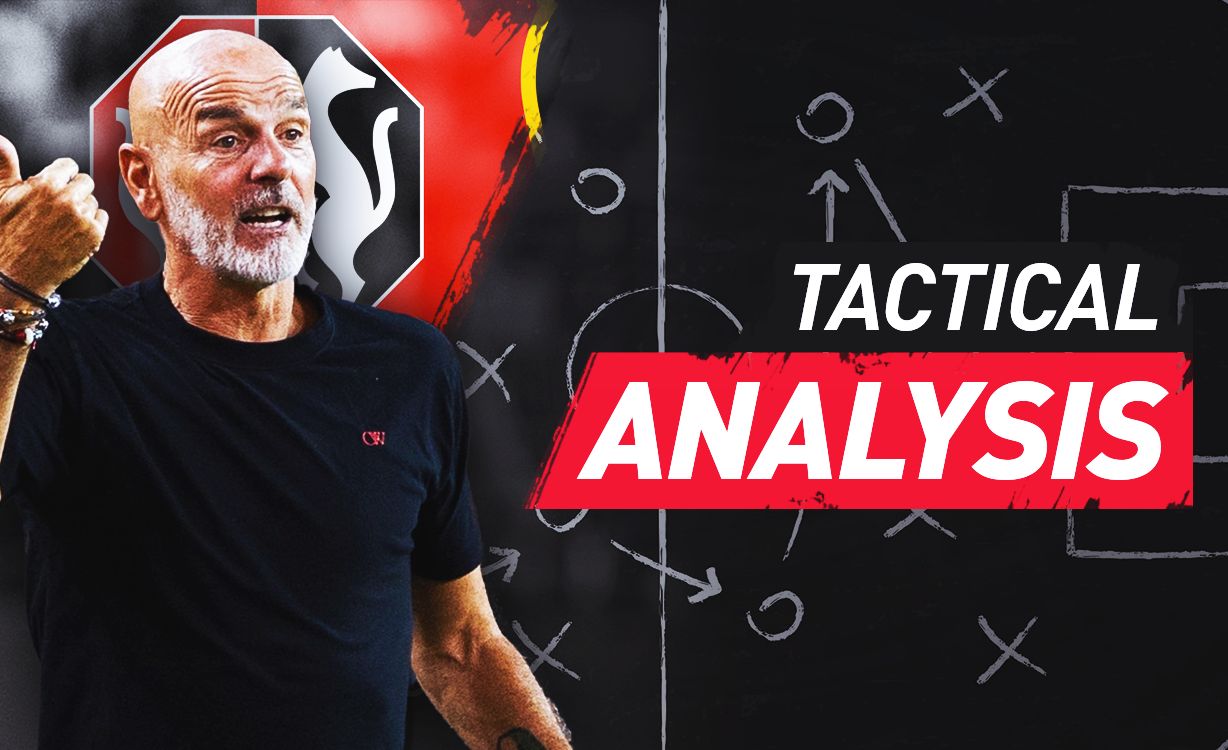
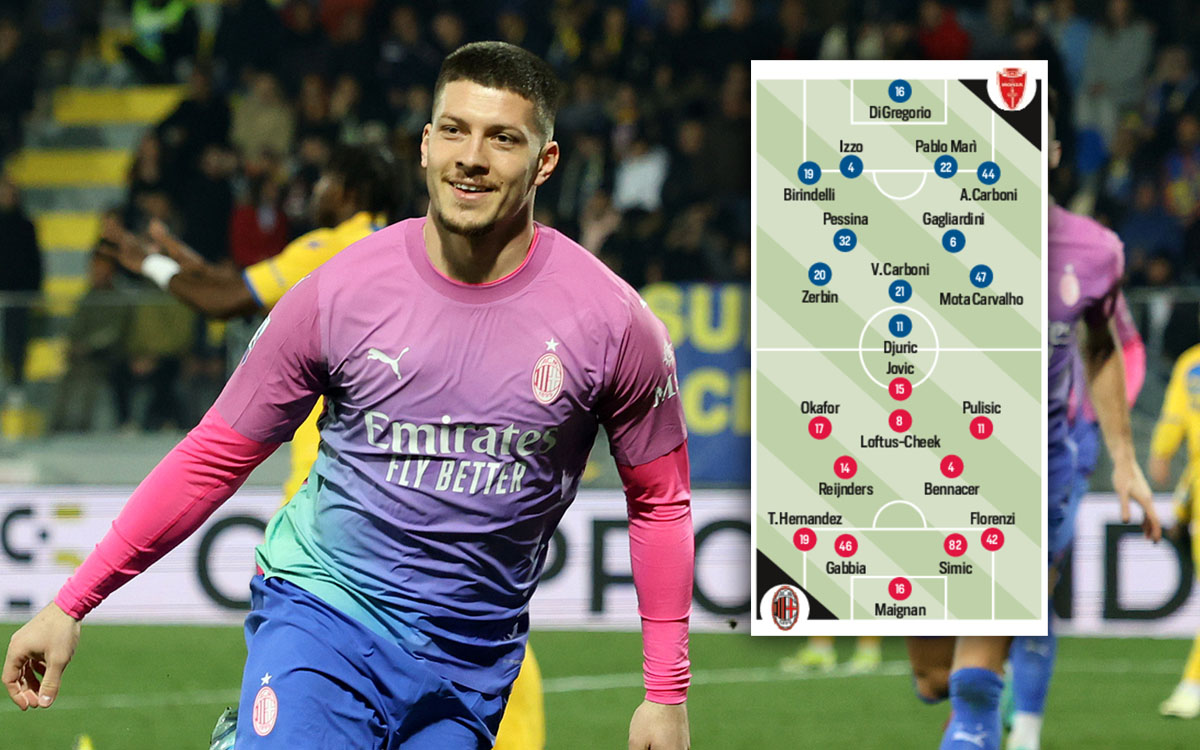
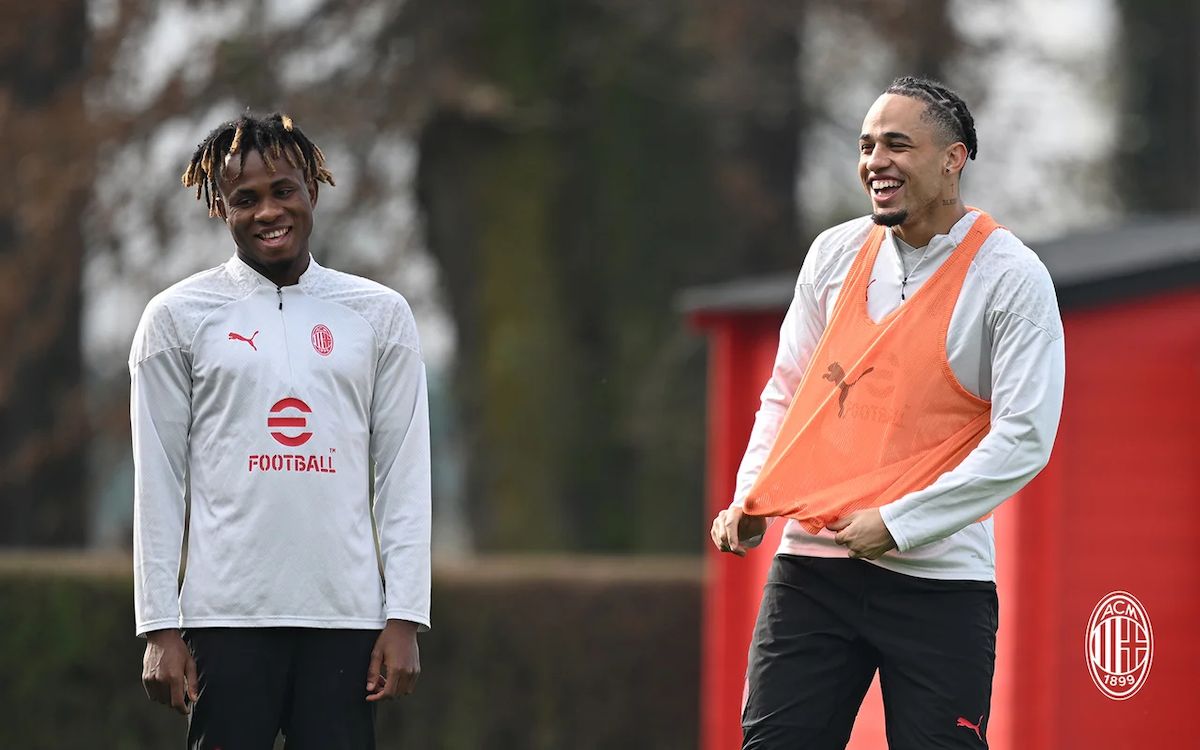
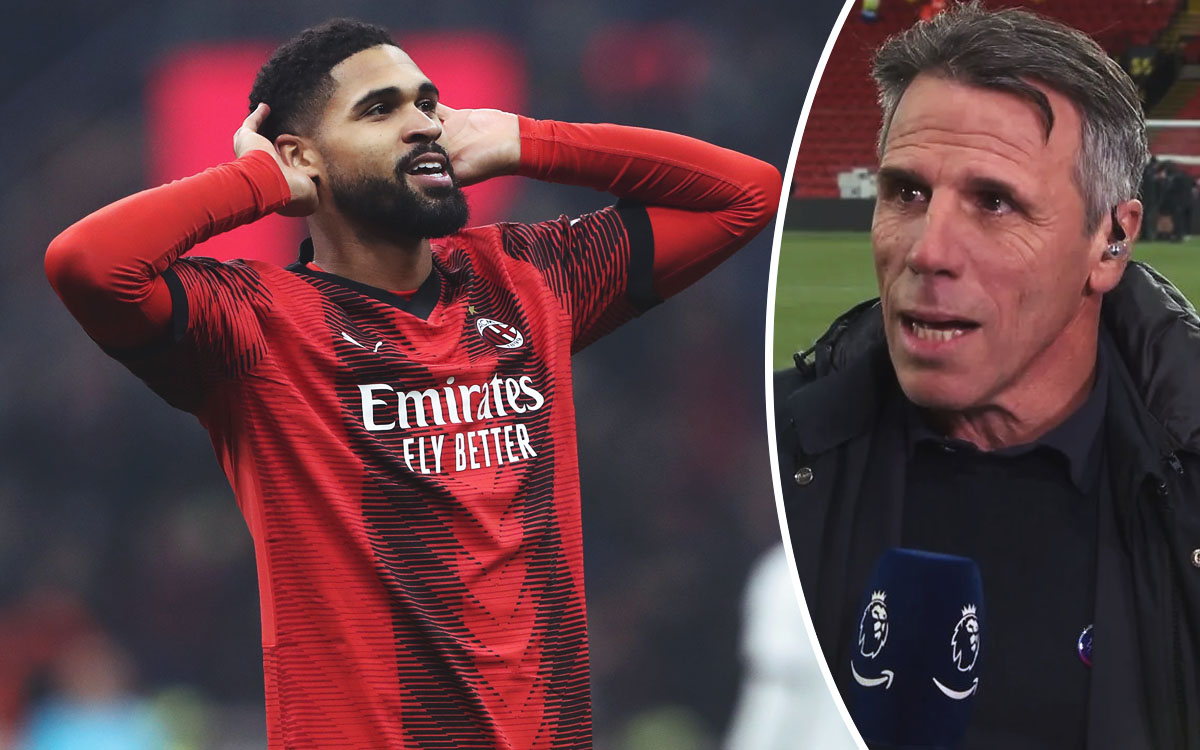

So… Some people blamed Adli & Calabria for the last two goals but clearly you can see there were severe errors made by others already before that duo appeared to the picture.
So it’s not like the GOAT-defending midfielder Krunic in Adli’s shoes would have made any significant difference. 🙂
“Reus who out paced and muscled Adli_” you missed that part. This is not 2017 Reus, how can Adli get beaten by old man Reus? But yea somehow Krunic shows up in all this ….btw where’s Reinjders? Strolling back from upfield….as the second double pivot? Lol wow. But yea…Krunic ….
“how can Adli get beaten by old man Reus?”
I dunno, maybe the same way De Vrij and Skriniar got beaten by even older man Giroud a couple of years ago. At least Reus has won things – unlike those two.
First: “but clearly you can see there were severe errors made by others already before that duo appeared to the picture.”
And your comment “But yea somehow Krunic shows up in all this ….btw where’s Reinjders? Strolling back from upfield….as the second double pivot? Lol wow. But yea…Krunic ….” just proved you clearly didn’t understand as my critique for others. Let me count 1+1 for you here. I said it would have made zero effect on the goals even if Krunic were on the pitch as the critical mistakes was made by other players. So how’s that on Krunic, eh?